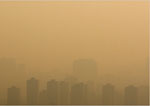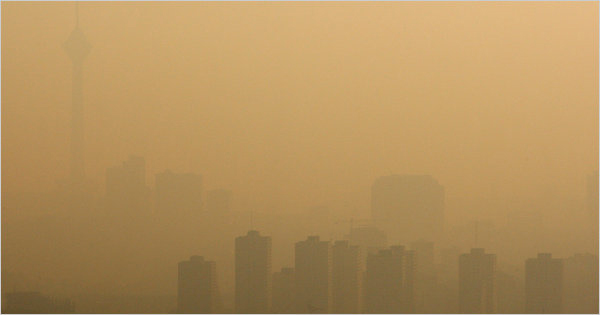 AP: Cities in Iran, India, Pakistan and the capital of Mongolia rank among the worst on the planet for air pollution, while those in the U.S. and Canada are among the best, according to the first global survey by the World Health Organization.
AP: Cities in Iran, India, Pakistan and the capital of Mongolia rank among the worst on the planet for air pollution, while those in the U.S. and Canada are among the best, according to the first global survey by the World Health Organization.
The Associated Press
By FRANK JORDANS, Associated Press
 GENEVA (AP) — Cities in Iran, India, Pakistan and the capital of Mongolia rank among the worst on the planet for air pollution, while those in the U.S. and Canada are among the best, according to the first global survey by the World Health Organization.
GENEVA (AP) — Cities in Iran, India, Pakistan and the capital of Mongolia rank among the worst on the planet for air pollution, while those in the U.S. and Canada are among the best, according to the first global survey by the World Health Organization.
The southwest Iranian city of Ahvaz walked away with the unfortunate distinction of having the highest measured level of airborne particles smaller than 10 micrometers.
WHO released the list Monday to highlight the need to reduce outdoor air pollution, which is estimated to cause 1.34 million premature deaths each year. The global body said investments to lower pollution levels quickly pay off due to lower disease rates and, therefore, lower healthcare costs.
The list, which relies on country-reported data over the past several years, measures the levels of airborne particles smaller than 10 micrometers — so-called PM10s — for almost 1,100 cities.
WHO recommends an upper limit of 20 micrograms for PM10s, which can cause serious respiratory problems in humans. They are mostly sulfur dioxide and nitrogen dioxide from power plants, auto exhausts and industry.
Ahvaz’s annual average of PM10s was 372 micrograms per cubic meter. Heavy industry and low-quality vehicle fuel are the main causes of air pollution in this desert city of 1.3 million.
The study found that the Mongolian capital Ulan Bator had an annual average PM10s density of 279 micrograms per cubic meter, followed by another west Iranian city, Sanandaj, with 254 micrograms.
Cities in Pakistan and India, such as Quetta and Kanpur, as well as Botswana’s capital Gaborone, also ranked high on the pollution scale.
Mohammad Hasan, 39, of Karachi, Pakistan, said attempts to improve air quality in the port city of 18 million — such as by replacing heavily polluting buses with vehicles using compressed natural gas — are being undermined by bigger polluters who are “playing havoc with the lives of Karachi populace.”
“Industries and factories are emitting thick clouds of smoke, and no government agency is out there to check them or correct them,” the bank employee said.
WHO said the reasons for high pollution levels varied, but that often rapid industrialization and the use of poor quality fuels for transportation and electricity generation are to blame.
In India, major metropolitan areas such as New Delhi, Mumbai and Kolkata have banned the construction of new power plants within city limits, and existing ones are being shut down or relocated.
But at the same time, a lack of public transport has led to an explosion of privately owned cars and SUVs as the economy booms, with the number of heavily polluting diesel vehicles increasing 10-fold as diesel is highly subsidized by the government.
In Ulan Bator, the air pollution is mainly related to the burning of coal, wood and everything else for heating, cooking, and electricity generation. Coal-fired power plants spew smoke over the city, which lies in a valley surrounded by mountains that trap and hold the pollution, much like Beijing.
Ulan Bator has also seen a huge influx of former herders and farmers who live in felt tents known as gers or wooden shacks with no heat and little electricity, relying on the burning of coal, wood and dried dung to keep warm and cook meals. Combined with vehicle emissions, that creates a heavy blanket of smog that smothers the city for most of the year and grows especially noxious in winter.
At the other end of the list are cities in Canada and the United States, which benefit from lower population density, favorable climates and stricter air pollution regulation.
Yukon territory’s capital Whitehorse had a yearly average of just 3 micrograms of PM10s per cubic meter, while Santa Fe, New Mexico, measured 6 micrograms.
“It’s absolutely wonderful,” said Whitehorse Mayor Bev Buckway. “A lot of people come up north and they smell the air and the say “‘Oh wow. Amazing. The air smells so good,'” she said. “And we tend to take it for granted because we just have that all the time.”
Santa Fe Mayor David Coss said Monday that he’s pleased but not surprised as the city consistently gets high rankings from the American Lung Association.
He said the clean air is one of the things he loves about living in Santa Fe.
Washington, D.C., had a level of 18 micrograms, Tokyo measured 23 micrograms, and Paris had 38 micrograms of PM10s per cubic meter.
WHO also released a shorter table comparing levels of even finer dust particles, known as PM2.5s. The level considered harmful there is 10 micrograms per cubic meter.
This list contained no measurements from Asia apart from Ulan Bator, which again ranked worst with 63.0 micrograms.
___
Ashraf Khan in Karachi, Jeri Clausing in Albuquerque, New Mexico, and Rob Gillies in Toronto contributed to this report.
WHO air pollution database: http://bit.ly/pTrCOx


